Proof That It’s Pre-Code
- Basically calls American evangelism out as being a performing art that exploits the dumb for the sake of profit. So that’s something!
- When dressed down by his boss, one employee closes the door and responds with a gesture whose meaning is unmistakeable:
 |
 |
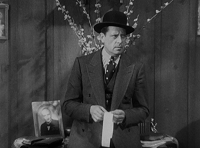 |
| Florence Fallon … Barbara Stanwyck |
John Carson … David Manners |
Bob Hornsby … Sam Hardy |
The Miracle Woman: The Mystery of It All
“Religion is like everything else, it’s great if you sell it, but no good if you give it away.”
Money above all. For all the talk about faith and freedom, America was founded in pursuit of lower taxes, wealth, and a better deal. And it’s been a race to the bottom ever since. The monetary brand of American faith has always been at a crossroads with the more traditional ones, the ones which preach about the rich having little luck of making it into heaven and how good people should help out the less fortunate.
When opportunism meets that philosophy, it becomes about miracles, stunts, and showmanship; here, namely, evangelical Christianity. That preacher standing at the front of the church must be in contact with God, after all. Look at all this ornamentation; can’t you tell how healthy their profit margins are?
This hucksterism is nothing new, as some segments of the American public seems to fall for anyone with a smooth line of jazz, a big stage show, and maybe even a couple of good magic tricks. The post-war 1920s were rife with this sort of chicanery, and a backlash emerged in the form of novels, plays, and this picture, all of which deride the evangelical industry for its many blatant hypocrisies.
Directed by Frank Capra, The Miracle Woman starts with a young woman named Florence Fallon (Barbara Stanwyck) giving a sermon at the church her father preached at for nearly three decades. Through the speech she reveals that despite his many years of service, he had been recently fired because of his old age, and without a penny to his name. She calls them out rightfully for being hypocrites, sinners six days a week and pious for one. This upsets the congregation who file out in bewilderment (behaving just like a flock would), and soon Florence is left sobbing in an empty church.

A stranger appears.
Well, empty save for one man. Bob Hornsby (Sam Hardy) happened to be in town, and makes an offer to Florence; exploit those saps who show up for their one day a week. Take to task all the bootleggers, swindlers, and adulterers. He tells her, “Most of the trouble in this world comes from having convictions.” She buys in.
And so Florence becomes a revival preacher, set up in a huge tabernacle on the outskirts of New York City. She praises God and promises all a ticket to the afterlife as long as they give generously and believe. Her sermons work as pitches for herself as well, and she notes to any doubters that it’s easy to forgive sinners, harder to forgive quitters. This particular message, probably more aimed at those who would question her methods, instead finds it way across the radio waves and into the ear of John Carson (David Manners).
Carson had joined the army to see the world during the Great War, but was rendered blind in combat and a tragic case of dramatic irony. Now he’s a recluse, tended to only by his kindly landlord Ms. Higgins (a delightful Beryl Mercer). When his musical compositions are rejected from the last publisher in the phone book, he’s about ready to jump out his window when his neighbor’s radio, blasting Sister Florence, changes his mind.

I love the little detail that the blind man accidentally wrote off the page a bit.
Renewed, he decides to go with Ms. Higgins to the revival. We get to watch the ceremony unfold as bleachers of cheerleaders surround the stage, and a spotlight follows Florence’s every move. Her grandstand for the evening involves locking herself in a cage of lions and preaching about the biblical tale of Daniel in the lion’s den; Hornsby, of course, has made sure the lions are well fed and has a few rifles pointed at them from offstage to just to keep his cash cow safe. During her sermon, John joins Florence in the cage, and both are touched immediately: she by his sincerity, he by her words.
And those words are bringing in the dough. Hornsby is relishing it, using plants in the audience to convince the crowds that fake miracles are appearing. Florence, whose guilt about the decptions is starting to shine through, feels battered down by his profit margin. He’s started getting possessive of her, and after she finds herself spending more time with John in his apartment in an attempt to rediscover her better side, his jealousy becomes dangerous.
For those scenes in the apartment, Capra gives us some of wonderfully tender scenes. Carson is sincere and shy, and Florence must constantly guard herself from his wonderful earnestness. Her fraudulent career is a silent wedge in their relationship, but he doesn’t have a clue; ironically, John is blinded by his love as well. The chemistry between Stanwyck and Manners glows here, as the two wage a delicate war.

She looks great in that hat, too, even though he’ll never appreciate it.
Hornsby’s jealousy grows more powerful, and, after he has a greedy promoter murdered, he begins pushing back against Florence, threatening to expose her as a fraud and implicate her in the murder if she doesn’t run away with him and do… you know, other things she doesn’t look too thrilled about. At this point she panics, and desperately notes, at this point, “God wouldn’t believe me under oath!”
She confesses the truth of her situation to John, and, amazingly, he wants to help her out of the jam. Things don’t go as planned, and Florence must decide whether or not she can continue with the fraud she’s perpetrating, or if she’s willing to come clean to exploiting hundreds of people.
The Miracle Woman is born out of the fabric of a decade of pain, touching on both war and the profit motive that lines the cage of America. George M. Cohan (he of Yankee Doodle Dandy fame) gets quoted multiple times, both as a showman and as a trumpeter of the American way; his battle hymn, “Over There”, helps bring people into the decadent religious ceremonies, again underlining the mockery of sincere patriotism and faith that evangelists use to exploit the masses.

This picture is a demonstration of what I like to call “professional actors being goddamn professionals.”
Capra does some really great work here in one of his first sound films, and Barbara Stanwyck, whose character motivations remain cloudy, still manages to craft a wholly sad and understandable persona. Manners, who was also quite charming back in Man Wanted, may be one of the few actors who could play a character with a disability so effortlessly. His performance is nuanced, making John so dorky– in one lengthy scene, he uses a ventriloquist dummy to woo Florence– that we witness it going from pathetic to adorable by just the sound of his voice.
If the movie never becomes as cutting or nasty as it could be, it’s because it’s obvious that Capra still held back. He made a romance movie with an issue, not an issue movie with a romance. It was still pushing the limits of what it could say about evangelical hucksters when it was made, and full enforcement of the Motion Picture Production Code in 1934 meant that even diluted message pictures like this were not much longer for the world.
Though The Miracle Women is a muted kind of masterpiece, filled with beautiful cinematography and nuanced, tender performances, it’s existence serves to demonstrate that the effects of censorship wasn’t just of ladies in their underwear. They were also political, allowing control of the filmic dialogue about faith and exploitation that would leave three future decades of American film essentially toothless. At worst, The Miracle Woman serves as a better signpost towards counterculture cinema of the 60s and 70s than many of the films that directly proceeded it. At best, though, the movie is a beautiful love story that just misses the mark of true greatness.
A Visual Breakdown

The disclaimer the film opens with. You can decide for yourself whether or not the film is actually a rebuke or not.

The early shots of Fallon in her father’s church do some interesting things, often looking up at her to give her the illusion of power. Here we see her from the back of the church, almost lurking behind a pillar. Her anger and sadness is so palpable here, the camera almost seems to want to run away from its power.

Hornsby spends a lot of the movie with his back to the audience, towering over Florence. His cruel domination is subtle at first, but unmistakeable.

Florence’s transformation into “Sister” Florence includes this wispy ditty. The lengthy, translucent sleeves call to mind wings of angels, and her robes are plain and simple in the ways of apostles.

This is our first shot of John as he contemplates ending his life. What I like about this perspective is A) how mundane the alley he’s considering jumping into is, and B) that we’re looking down below, but at this point in the movie, we don’t know that John is blind. So we’re looking at the plain mundane sadness he’s contemplating, but with information the character doesn’t have.

‘Temple of Happiness’ isn’t very subtle, is it.

Fallon is branded incredibly well. Throughout the film her initials are usually seen on both sides of the cross, equating them in the mind’s eye.
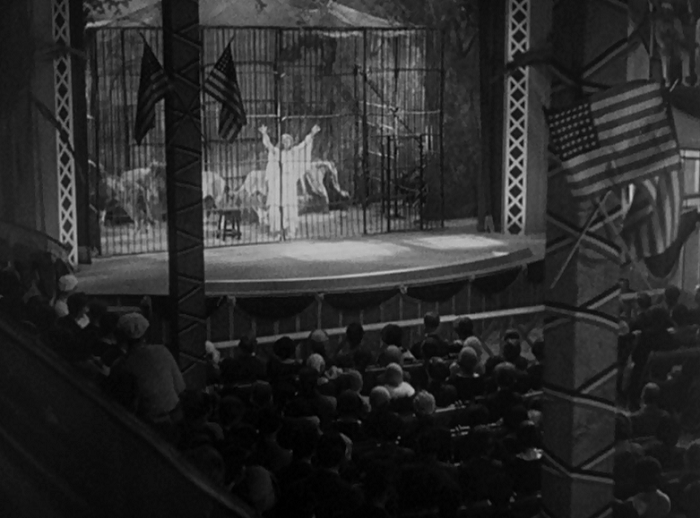
Here are some strategically placed American flags.
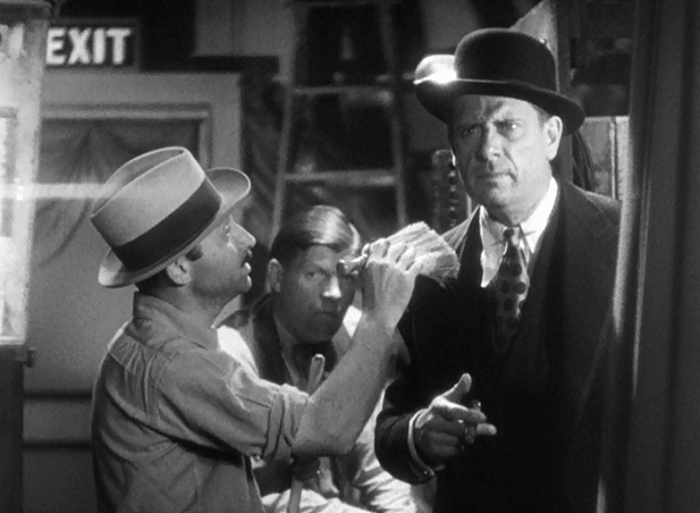
This is a great subtle bit, where a worker comes up and starts casually brushing off Hornsby. The man is such a dirty cheat, people feel compelled to clean him off without prompting!

The scenes set in Johns apartment are great, since you can tell so much about him from its decorations– books filling up every surface, the propeller on the wall. Especially nice is when they enter the apartment and banter, and it takes a while for John to remember that the lights are off. With the rain outside, it makes the mood absolutely charming.

Stanwyck walks in on a carnie party to discover them openly mocking her routine. Capra openly compares her work to that of the carnival workers who hold themselves above their audience and fleece them with glee. This shot shows Stanwyck (in the bottom left) on the outside seeing how awful this looks from the outside, and she’s about to be drawn in…
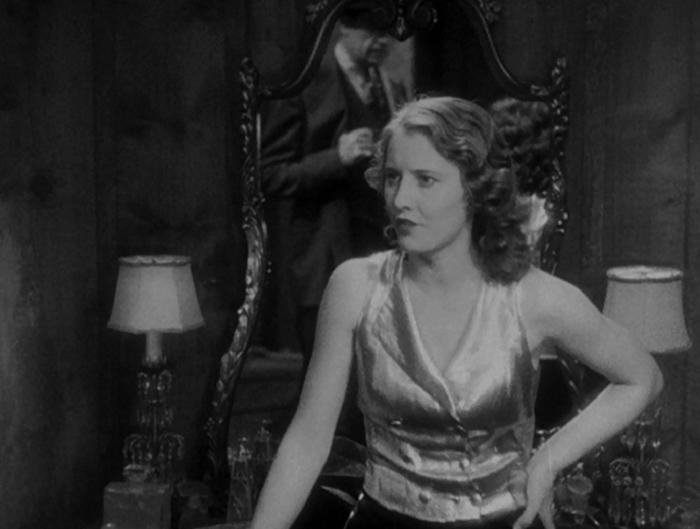
We never see Florence preach outside of her first encounter with John, which further fuzzes up how complicit she is in the affair. However, if her early outfit looked angelic, later she changes into a number that’s more along the lines of a drum majorette. Appropriate for the cheerleaders that she’s leading. Another note: look at the framing of Hornsby in the mirror; absolutely perfect use of its shape and some shadow to make him extra threatening.

Here is Florence realizing that she’s shamed her father by being a shill. Capra’s use of movement here is pretty unique, and a lot of his direction has a great flow to it that is rarely seen in the mostly stagey direction of the era.

This shot has us peering over John and Florence’s shoulders. It’s brief, but very intimate. I should have more to say here, but it’s just a wonderful moment as he begins to read a Bible verse from reading the braille and she finishes it for him from memory.

Hornsby making his threats. Again, back to the audience; Capra actually has him sitting in a way so that for part of the scene where Florence is in her apartment, unaware of her presence, we have the same perspective as him. The actor for Hornsby, Sam Hardy, is excellent in this picture, making the man despicable but not cartoonish. He’s vile through and through, but stays true to life at the same time.

This is the big reason I wanted to do the visual breakdown of this film. Capra could not have gotten away with a lot of overt religious symbolism in this film, especially considering how Bible-literate most of his audience probably was, but this one shot reveals his connections pretty well. Because compare this to…

… the statute La Pieta in Rome (source). Florence’s Christ-like compassion at the end of the film, where she almost sacrifices her life and well being to save hundreds of others, earns her this moment of redemption.

This caption’s got spoilers, so skip it if you don’t want to know ’em. This is the film’s last shot, with Florence in the Salvation Army while Hornsby looks on befuddled. Florence has realized that true service to God is through piety, while Hornsby again drives home both his and America’s obsession with the dollar: “And she gave up a million bucks for that. The poor sap.” He pities her because even though all the money meant being both sacrilegious and, essentially, a sex slave, in his mind, it would have been worth it!
Gallery
Here are some extra screenshots I took. Click on any picture to enlarge!





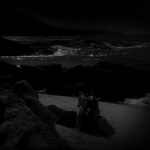







Trivia & Links
- This post is part of the Barbara Stanwyck Blogathon hosted by The Girl With the White Parasol. Check it out to see a lot of great posts by a lot of great writers about one of the greatest actresses! Also, if you’re bored, you can see all the Stanwyck movies I’ve reviewed for this site here, as well as my take on Double Indemnity with my pal Ryan over at Can’t Stop the Movies.
- Movie Classics has a good article (and some great comments, too) about the picture. Judy’s observation of how Al’s presence mimics Florence’s role as a mouthpiece are great, and one commenter smartly points out similarities between Kafka and one of the film’s more memorable set pieces.
- If you’ve seen the movie, you almost have to admire Hornsby’s ability to have every single top headline in the city’s newspaper related to Sister Florence. That’s good PR work to say the least.

Rewatching the movie, I loved noting how bright and prominent the Exit signs are, since they’re not something you notice the first time through yet play heavily into the film’s climax.
- This is part of the Early Frank Capra Collection that came out a few months ago, which includes another of other Pre-Codes I’ll be touching on in the immediate future. DVD Beaver does a rundown on how the set looks.
- The TCMdb has an article (recreated on the film’s DVD) that talks about the making of the film. Besides revealing that Capra was in love with Stanwyck (and who can blame him?), here it touches on Stanwyck’s early acting technique:
Fresh from the Broadway stage, Stanwyck was an instinctive actress who had yet to learn the formidable film technique that became the hallmark of her later performances. But at the time she gave her all on the first take, so Capra arranged to have her shot by multiple cameras, instructing her to keep going with the scene no matter what errors were made or what the other actors did. With this technique he could recapture Stanwyck’s fresh reactions in the editing room.

One of my favorite gags in the film was Ms. Higgins getting hit on at the revival. Very cute stuff.
- A blog about Frank Capra covers this and talks about how it compares to the famous novel Elmer Gantry and what strange remote influence Lon Chaney may have had on a few scenes.
- The David Manners Fansite notes that this was one of the actor’s own personal favorite performances. The site is written by someone who knew Manners later in life and has lots of interesting tidbits, too.
- In case you were worried that 1930’s films were magically politically correct, John owns a Sambo doll, while one scene involves everyone equating Florence with a “coon shouter”.

One last kiss before the afterlife.
- Mordaunt Hall’s review in the New York Times this week is actually pretty well observed, and makes a few good summaries:
This feature is clogged with detail and it is seldom that anything logical happens in the course of the narrative. Yet Miss Stanwyck, Mr. Manners and Sam Hardy, who impersonates Hornsby, gives clever performances. Beryl Mercer also does well as the friendly old caretaker of Carson’s apartment.
- Lastly, Movie Diva touches on the evangelist craze that sprung up post-World War I, and talks about some of the influences that are reflected in Miracle Woman. Here’s the best:
But, best of all was Sister Aimee McPherson and her Four Square Gospel. Sister Aimee dressed like an angel and in Los Angeles her Angelus Temple held thousands of the faithful. Those who could not attend in person listened on the radio. “In her famous throw-out-the-lifeline number, the former Ontario farm girl had a dozen imperiled maidens cling to a storm-lashed Rock of Ages while special effects men worked heroically with thunder, lightning and wind machines. Just when all seemed lost, Sister Aimee in an admiral’s uniform appeared and ordered a squad of lady sailors to the rescue.” (Axel Madsen).
Awards, Accolades & Availability
- This film is available on Amazon and TCM, and can be rented from Classicflix.
|
|
Leave a comment or join our email subscription list on the sidebar!Home | All of Our Reviews | What is Pre-Code? |

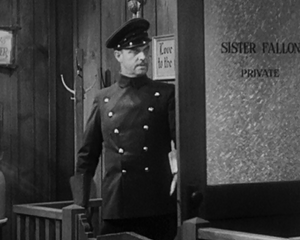




31 Comments
KimWilson · July 16, 2013 at 8:16 am
I always like to watch these earlier Stanwyck films because they showcase her raw talent. While she became a more nuanced actress with more cinematic endeavors, the Pre-Code years always show more of Stanwyck was as a person.
Danny · July 16, 2013 at 4:01 pm
Watching through all of her earlier pics, I have to agree with you. She’s got a nice intensity that begins to fade into toughness as her roles progress. Compare her work here to something a decade later like Ball of Fire, and she’s much less vulnerable there, even if she’s playing a more vulnerable role! That’s okay, I’m a fan of Stanwyck, and I’ll take her in any flavor I can get. 🙂
Patricia Nolan-Hall (@CaftanWoman) · July 16, 2013 at 8:25 am
I love these films that show today’s audiences that there’s really nothing new under the sun.
Enjoyed the article immensely, especially the praise for David Manners. Stanwyck and Capra are an intriguing team.
Danny · July 16, 2013 at 4:05 pm
They sure are. They made some great stuff together in the early 30s, and I’m really glad that all of it is finally available on DVD!
David Inman · July 16, 2013 at 8:55 am
This movie really does have its heart on its sleeve, in a good way. Seems like Capra and Stanwyck felt it wasn’t successful, but I disagree.
Danny · July 16, 2013 at 4:06 pm
I agree, too. I think Capra was trying to go too high with this one, and disappointed mainly himself.
Judy · July 16, 2013 at 11:25 am
Danny, glad to hear you were impressed by this one – must agree it’s a great early movie for both Capra and Stanwyck. I like your point about Manners’ different types of blindness in the film, and your point on this film being “born of a decade of pain”… and the comparison with the Pieta is stunning. And thanks so much for the link and nice comment on my old piece.
Danny · July 16, 2013 at 4:46 pm
My pleasure, Judy. Thanks for reading!
FlickChick · July 16, 2013 at 12:51 pm
Oh boy – do I love this film – and your post just as much. Fantastic work!
Danny · July 16, 2013 at 4:46 pm
Thanks, I appreciate it!
Aubyn Eli · July 16, 2013 at 2:32 pm
Danny, this post just blew me away. I feel really amazed and happy to have a piece of this caliber in the blogathon. You really go through every detail of this film, but in a way that leaves people wanting to discover it for themselves. I saw this one a few years ago and enjoyed it, but you’ve given me so much to think about. I agree that
David Manners is really endearing in this film. His awkward courtship of Stanwyck feels like a precursor to the similar dorky attractions of Longfellow Deeds and Jefferson Smith. Except I think I enjoy it better here because the characters are drawn in a less exaggerated manner, with neither of them coming off as total cynic or total saint.
I appreciate your take on Capra here since I think all his early Stanwyck films show him working at a pretty advanced level. I haven’t seen his earliest work but he comes off a man who understood the cinematic tools at his disposal and how he could take advantage of the medium. That final sequence is hair-raising.
I do remember reading a critic once (can’t recall the name) that said it must be down in Stanwyck’s contract somewhere that every movie she’s in, she gets to tell someone off at the top of her lungs. Well, it might not be true of all Stanwyck movies, but it’d be hard to deny the power of her intro scene here. When she tears into the churchgoers, you almost expect thunder to strike them all dead.
Anyway, this was an incredibly enjoyable post and now all I want to do is watch the movie again.
Danny · July 16, 2013 at 5:09 pm
Capra’s one of the few directors who didn’t let the advent of sound get in the way of his artistry. He still tried to make tough, insightful pictures with graceful camera movements and beautiful cinematography even with all the challenges that entails. And, yeah, the dorky Manners here works far better than he has any right to.
Thanks for your kind words, and thanks for the lovely blogathon!
silverscreenings · July 16, 2013 at 3:13 pm
Amazing post! I have never seen this film but, brother, you’ve sold me. 🙂
Danny · July 16, 2013 at 4:00 pm
I hope you enjoy it! Like I said, it’s not the greatest message picture, the romance is what makes the movie special.
Jandy · July 19, 2013 at 12:25 pm
This was one of the biggest (and best surprises) for me when a rep cinema did an early Capra retrospective a few years back. I had heard mixed things about it, but I ended up really liking it, and especially Stanwyck in it. It’s earnest in all the best ways, and she is a force to be reckoned with on every level. Sadly, I missed some of the other Capra-Stanwyck collabs they showed; I wish I’d been able to see them all! He knew how to bring out something special in her – not that she’s not always special, of course!
Danny · July 19, 2013 at 6:45 pm
Their collaborations in the Pre-Code era are really only comparable to von Sternberg and Dietrich: he helped mold her into something truly amazing. I’ve got reviews for the other three coming up in the next few weeks, and no one photographs her with quite as much love. They’re all available in the Early Capra collection from TCM, which can bee rented from all good classic film rental places. 🙂
Jandy · July 20, 2013 at 10:33 am
I’ve had my eye on that Early Capra collection for quite a while – just haven’t bitten the bullet on it yet. Maybe a Christmas present to myself in a few months. 🙂
Danny · July 20, 2013 at 4:56 pm
Ditto! I think they have some decent sales on it every once in a while, just gotta keep my eyes open. 🙂
LadyE · July 19, 2013 at 12:58 pm
All I can say is Brava, bravo, bravo…Fan-tas-tic!
Danny · July 19, 2013 at 6:47 pm
Thank you so much! That means a lot coming from you!
LadyE · July 20, 2013 at 10:09 am
Not only your reviews are insightful…they are also entertaining! I was wondering if I could add a link to your Stany pre-code reviews to my website. I have the pending tedious task to add a page for each of her 80+ films and a section of the page will be dedicated to links to meaningful reviews.
Danny · July 20, 2013 at 4:57 pm
I’ve never said no to links. 🙂 I’ve already been poking around your site a bit, looks great!
Le · July 21, 2013 at 11:53 am
I loved your essay on my favorite Stanwyck pre-Code. You made some points that I hadn’t paid attention before. Capra was a very subtle filmmaker, and I believe we much watch his films several times to catch all the details.
Don’t forget to read my contribution to the blogathon! 🙂
Greetings!
Danny · July 22, 2013 at 7:23 am
Thanks, I appreciate it! I’m a big fan of Capra, and Miracle Woman has a lot of really smart stuff going on in it. I’ll be hitting his other three collaborations with Stanwyck soon!
Thom Hickey · June 7, 2014 at 4:05 pm
Thanks. A superb study of an excellent film. Regards from Thom at the immortal jukebox.
Danny · June 7, 2014 at 4:36 pm
Thank you!
Chris L. Christensen · December 16, 2016 at 4:41 pm
Obviously this movie was made to exploit and Stanwyck’s character was hugely patterned after Aimee Semple McPherson. McPherson was such a bigger-than-life character that it is hardly a surprise a movie about her in all but name would be made in the Pre-code era. McPherson’s real life is much more fascinating, interesting and unbelievable than any movie could possibly portray! Her life absolutely sums up the adage “Truth is Stranger than Fiction”. I agree with your assessment that Capra and even Stanwyck in her magnificent performance were subdued and held a lot back. McPherson’s name, scandals and life were in the papers on a daily basis for most of her life and Aimee’s mantra seemed to be “there is no such thing as bad publicity”. Aimee herself was a master at creating and keeping interest in herself. During the very time that this movie was being made McPherson was having a highly publicized fight with her mother over control of her big church in Los Angeles, Angelus Temple and the accompanying organization so the real Aimee would have been hard to ignore in 1931. Bette Davis had a big interest in Aimee Semple McPherson and wanted to make a movie about her after Aimee’s death in 1944 but no studio in the Post-Code era would touch anything like this. There was a TV movie in 1974 with Davis portraying Minnie Kennedy, Aimee’s mother, and Faye Dunaway portraying McPherson. The movie called “The Disappearance of Aimee” centered on the faked kidnapping of Aimee in 1926 and the ensuing huge scandal. Although interesting, Dunaway just didn’t capture the real Aimee and Davis expressed great disappointment with the movie and Dunaway’s performance.
Comments are closed.